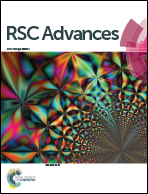Ru–Fe alloy mediated α-Fe2O3 particles on mesoporous carbon nanofibers as electrode materials with superior capacitive performance†
Abstract
We herein first report Ru–Fe alloy mediated α-Fe2O3 particles on mesoporous carbon nanofibers (RuFe@Fe2O3/mCNF) as electrode materials. Such ternary composites are facilely fabricated by skillful construction of Ru, Fe-containing zinc–trimesic acid metal organic framework fibers before one-step pyrolysis. The resulting RuFe@Fe2O3 particles (20–33 nm) are evenly dispersed and firmly embedded into mesoporous carbon nanofibers formed simultaneously. In-depth characterization reveals that the RuFe@Fe2O3 particles are mainly Ru(+3) substituted α-Fe2O3, present on the periphery of Ru–Fe alloys. Particle size, as well as composite porosity and conductivity are readily tailored by controlling the feed ratio of RuCl3 to FeCl3. The elaborately fabricated RuFe@Fe2O3/mCNF-25% (25 at% Ru in total metals) delivers a large specific capacitance of 285 F g−1 at the scan rate of 1 mV s−1 and a high energy density up to 47.6 W h kg−1 at the current density of 0.25 A g−1. It also shows good rate capability and outstanding cycling stability up to 5000 times (only 4.7% loss). Such a electrode has great potential for practical applications in electrochemical capacitors.



 Please wait while we load your content...
Please wait while we load your content...